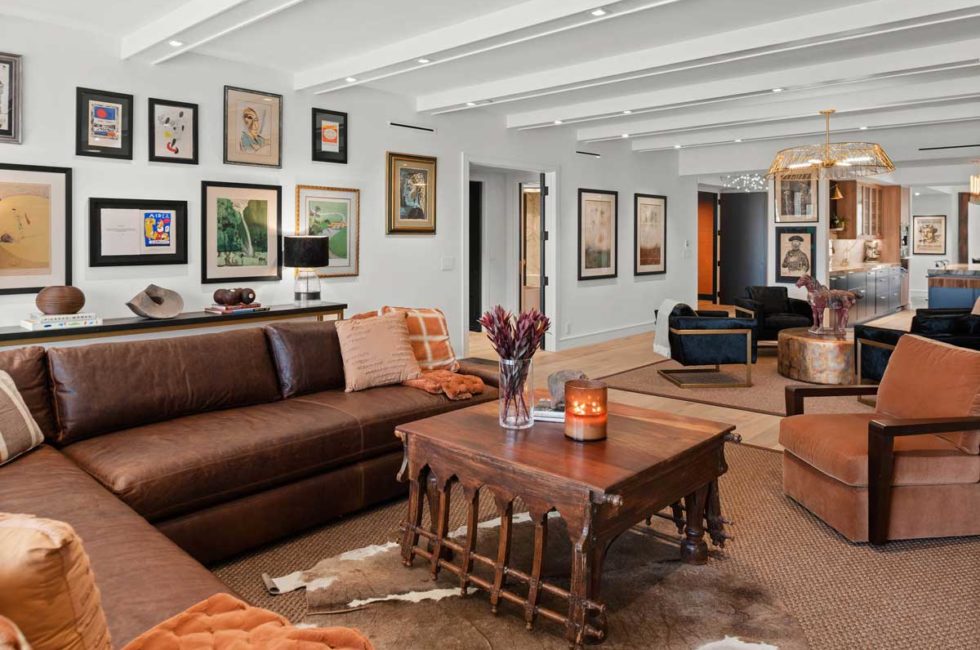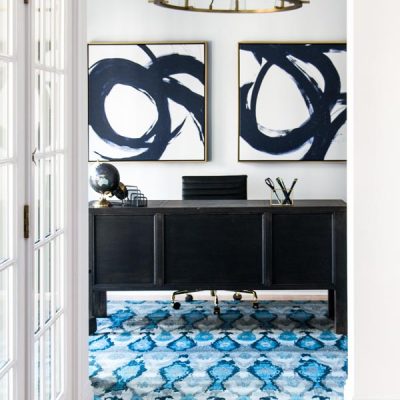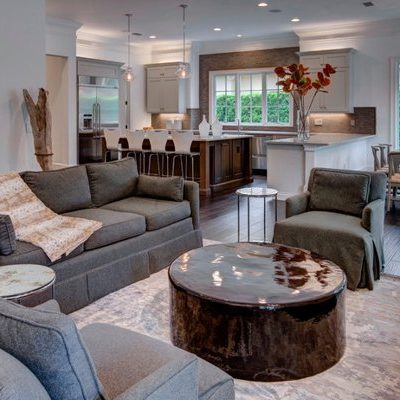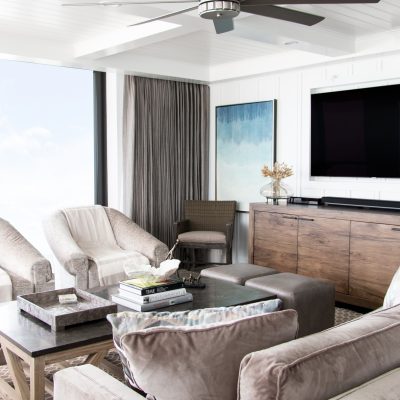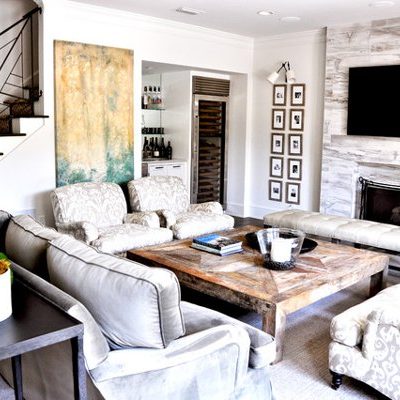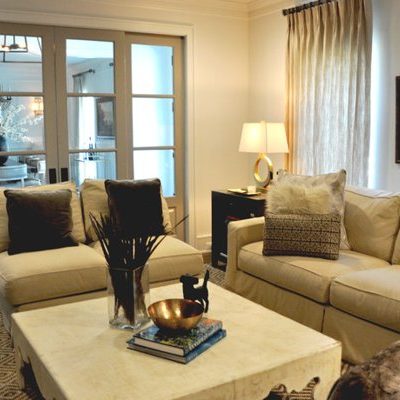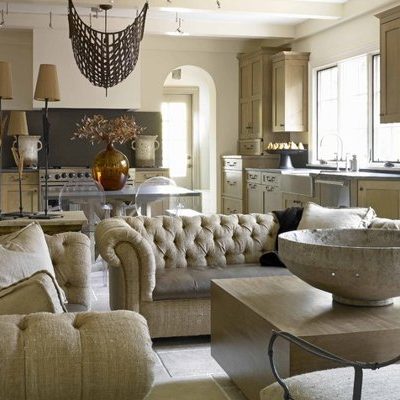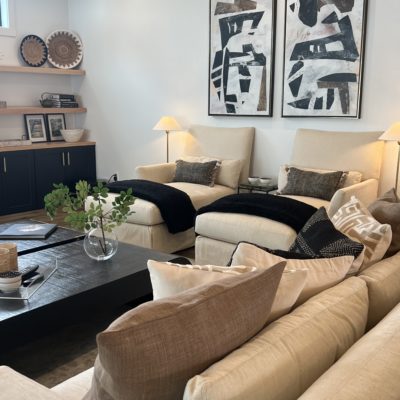The living room is a multi-functional space that is often the heart of the home and a reflection of the owner’s style. For these reasons, it is often considered the most important room in the house.
And we would whole-heartedly agree! Living room design is one of the most important parts of interior design. Knowing how to structure and design your living room is a skill we use every day as interior designers in Winter Park.
But where do I start with living room design? Remember, the design process is a journey and it’s important to enjoy it! Don’t be afraid to try new things and experiment with different styles and ideas.
In the meantime, here are a few basic tips to help you structure your living room:
Focal Points
Determine the main feature in the room, such as a TV, fireplace, or artwork, and arrange furniture around it. A focal point in a living room is a visual feature that draws the eye and anchors the space. It’s eye-catching. It grabs you. It serves as the center of attention and creates a sense of balance and purpose in the room. To define a focal point in a living room, you should consider the following steps:
- Determine the room’s purpose: Identify what activities you’ll be doing in the living room, such as watching TV or reading, to help you determine the best focal point.
- Assess the room’s architecture: Look for existing elements like a fireplace, large window, or a piece of artwork that can serve as a natural focal point.
- Consider the room’s layout: Decide on the best placement for the focal point based on the room’s layout and the flow of traffic. (more on that later!)
- Make it visually prominent: Highlight the focal point by arranging furniture to draw attention to it and by adding lighting or decorative elements that accentuate it.
A focal point in a living room creates a sense of purpose and flow in the space, making it more inviting and visually appealing.
Create Zones
Divide the room into different areas for different activities, such as a seating area for conversation, a media zone for entertainment, and a reading nook. Creating zones in a living room involves dividing the space into separate areas to accommodate different activities and uses. This allows you to create a functional and efficient layout while also defining the different areas in the room. Here are the steps to create zones in a living room:
- Determine the activities: Consider the different activities that will take place in the living room, such as watching TV, reading, entertaining guests, or playing games. Which is most important to you and your family?
- Plan the furniture placement: Arrange furniture in a way that defines the different zones and supports the intended activities. For example, place a couch and chairs near the TV for a relaxing area and a table and chairs near the windows for a reading area.
- Use rugs and other floor coverings: Rugs can help to define and separate different zones in the living room. Add storage: Consider adding storage units, such as bookshelves, to create additional zones and to help keep the space organized.
- Add lighting: Different lighting fixtures and lamps can help to define the different zones and create different moods in the room.
It’s easy to create distinct zones in a living room that allow you to make the most of the space and accommodate different activities and uses.
Using Furniture to Define Space
Place larger pieces of furniture, like a sofa or sectional, to define the perimeter of the room and create clear boundaries for each zone. Furniture is an important element in defining the living room space, as it serves as both functional and decorative pieces. Here are some ways to use furniture to define the living room space:
- Consider a furniture focal point: Use a large piece of furniture, such as a sectional sofa or an armchair, to create a focal point in the room.
- Define seating areas: Arrange furniture, such as sofas, chairs, and ottomans, in a way that creates defined seating areas for different activities, such as conversation or TV viewing.
- Separate zones: Use furniture, such as bookcases, shelves, or room dividers, to separate different zones in the living room, such as a reading area or a TV area.
- Accentuate with accessories: Use decorative items, such as throw pillows, blankets, and art pieces, to accentuate the furniture and create a cohesive look in the room.
Focus on creating a functional and visually appealing layout that meets your needs and enhances the overall look and feel of the room.
Ensure Good Traffic Flow
Arrange furniture to allow for easy movement around the room, leaving enough space for people to walk comfortably between pieces. Creating a good traffic flow in a living room design is important to ensure the room is both functional and comfortable. Here are some steps to create a good traffic flow in a living room:
- Determine the main paths: Consider the different ways people will move through the living room, such as from the front door to the couch, or from the kitchen to the TV area.
- Plan the furniture placement: Arrange the furniture in a way that allows for easy movement and does not block the main paths in the room. For example, place sofas and chairs in a way that allows for easy access to the TV or the windows.
- Allow for adequate space: Leave enough space between furniture pieces to ensure people can move comfortably through the living room. A minimum of 36 inches of clear space is recommended.
- Consider the room’s shape: The shape of the room can also impact the traffic flow. If the room is narrow, arrange the furniture along the walls to create a more open feeling. If the room is wide, arrange furniture in a way that creates defined zones.
- Use rugs and floor coverings: Rugs and floor coverings can help to define and direct the traffic flow in the living room.
By following these steps, you can create a living room with a good traffic flow that allows for easy movement and makes the most of the space.
Add Lighting
Use a combination of overhead lighting, lamps, and task lighting to brighten the room and create a warm and inviting atmosphere. Adding lighting is an important aspect of creating a gorgeous living room. Here are some best ways to add lighting to your living room:
- Use multiple light sources: Combine different types of lighting, such as overhead lighting, task lighting, and accent lighting, to create a well-lit and visually interesting room.
- Install a statement fixture: A statement lighting fixture, such as a chandelier or a pendant light, can add both functionality and aesthetic appeal to the living room.
- Use table lamps: Table lamps are an easy and effective way to add accent lighting to the living room and create a warm and cozy atmosphere.
- Add wall sconces: Wall sconces are a great way to add task lighting and accent lighting to the living room and can be used to highlight art or other decorative elements.
- Use floor lamps: Floor lamps are a versatile lighting option that can be used to add task lighting or accent lighting to the living room.
- Dimmable lighting: Dimmable lighting allows you to adjust the brightness of the lights to create the perfect mood for any occasion.
In no time at all, you can create a living room that is well-lit, visually appealing, and cozy.
Accessorize Wisely
Add personal touches to the room with decorative items, such as throw pillows, rugs, and curtains, to bring the space together. Accessorizing a living room can make a big impact in creating a cozy and inviting space. Here are some tips on how to accessorize a living room:
- Use textiles: Soft and cozy textiles, such as throw blankets, cushions, and rugs, can make a big difference in the overall feel of the room.
- Add plants: Adding plants to the living room can bring life and a touch of nature to the space, and can also help to purify the air.
- Display art: Art can be used to create a focal point and add personality to the living room. Choose pieces that reflect your personal style and complement the room’s decor.
- Incorporate candlelight: Candles can create a warm and inviting atmosphere in the living room and are a great way to add ambient lighting to the space.
- Use books: Books can be used to add color, texture, and interest to the living room and can also be a source of inspiration and comfort.
- Include a statement piece: Choose a statement piece, such as a large piece of artwork or a unique piece of furniture, to add a touch of individuality and interest to the room.
You can easily create a living room that is both functional and cozy, and that reflects your personal style and tastes.
Test The Layout
Once you have a plan, stand in the room and make sure you can easily move around and access all areas. Make any necessary adjustments to ensure a functional and comfortable layout. Testing the layout of your living room after making changes can help you assess whether the changes have had the desired effect and ensure that the room is functional and comfortable. Here are some ways to test the layout of your living room:
- Live with the changes: Give yourself time to live with the changes and see how the room feels on a daily basis. This will help you get a sense of how the room functions and whether the changes have had the desired impact.
- Use the room: Use the living room as you normally would and observe how the furniture and accessories interact with each other and with the rest of the room.
- Consider traffic flow: Consider how people move through the room and whether there are any bottlenecks or areas where people are tripping over furniture.
- Check lighting: Check the lighting in the room and see if there are any areas that are too dark or too bright.
- Test functionality: Test the functionality of the room by trying out different activities, such as watching TV, reading, or entertaining guests, to see if the layout supports those activities.
By testing the layout of your living room after making changes, you can ensure that the changes have had the desired effect and that the room is functional, comfortable, and aesthetically pleasing.
Is there an app to arrange your living room?
Yes, there are several apps available that can help you arrange your living room virtually.
These apps use augmented reality technology to allow you to place furniture and decor in a virtual representation of your space. Some popular options include:
- Room Planner by Home Designer: This app allows you to create floor plans, add furniture and decor, and visualize different design options in 3D.
- IKEA Place: This app lets you place IKEA furniture and decor in your living room to see how it would look in real life.
- Magicplan: This app allows you to create floor plans, add furniture and decor, and view your design in 2D and 3D.
- Planner 5D: This app lets you create floor plans, add furniture and decor, and visualize your design in both 2D and 3D.
These apps will allow you to easily experiment with different furniture arrangements, decor styles, and color palettes until you find the perfect look for your living room.
Final Thought
Pause and appreciate the beauty of living room interior design. This space is where we gather, entertain, and make memories with our loved ones, and it deserves to be a reflection of our personal style and taste.
Whether you prefer a cozy and intimate atmosphere or a chic and modern vibe, the possibilities are endless when it comes to designing your living room. Let’s take a moment to celebrate the art of transforming a space into a functional and beautiful haven

